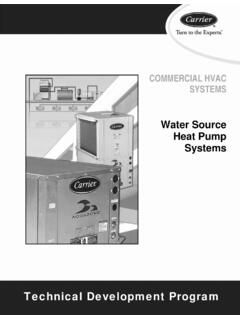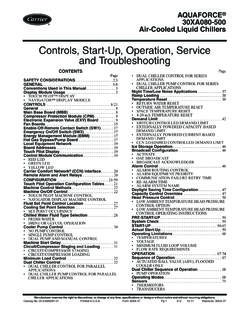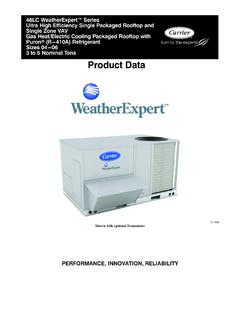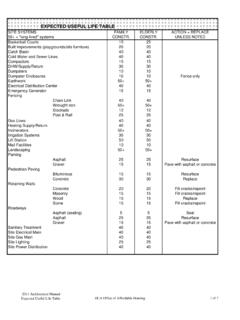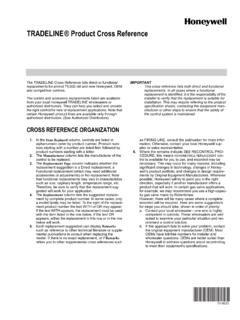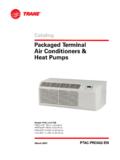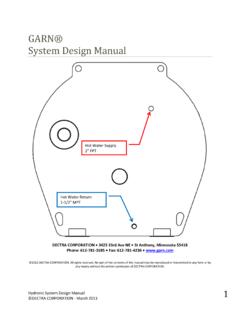Transcription of Water Piping and Pumps - Sigler Commercial
1 Water PipingandPumpsDISTRIBUTIONSYSTEMS Technical Development Programs (TDP) are modules of technical training on HVAC theory, system design, equipment selection and application topics. They are targeted at engineers and designers who wish to develop their knowledge in this field to effectively design, specify, sell or apply HVAC equipment in Commercial applications. Although TDP topics have been developed as stand-alone modules, there are logical group-ings of topics. The modules within each group begin at an introductory level and progress to advanced levels.
2 The breadth of this offering allows for customization into a complete HVAC curriculum from a complete HVAC design course at an introductory-level or to an advanced-level design course. Advanced-level modules assume prerequisite knowledge and do not review basic concepts. Water Piping and pumping is a fundamentals topic of HVAC design. The correct layout, se-lection and sizing of the Piping system and associated hydronic components is required to properly deliver chilled and hot Water as required to maintain comfort conditions.
3 Piping connec-tions at various equipment are covered, along with Piping arrangements for chilled Water systems. Pump basics, pipe sizing, and a pump selection example complete the TDP. 2005 Carrier Corporation. All rights reserved. The information in this manual is offered as a general guide for the use of industry and consulting engineers in designing systems. Judgment is required for application of this information to specific installations and design applications. Carrier is not responsible for any uses made of this information and assumes no responsibility for the performance or desirability of any resulting system design.
4 The information in this publication is subject to change without notice. No part of this publication may be reproduced or transmitted in any form or by any means, electronic or mechanical, for any purpose, without the express written permission of Carrier Corporation. Printed in Syracuse, NY CARRIER CORPORATION Carrier Parkway Syracuse, NY 13221, Table of Contents Introduction .. 1 Types of Piping Systems .. 1 Closed-Loop (Evaporator) .. 1 Open-Loop (Condenser) .. 2 Once-Thru .. 2 Water Distribution Systems .. 3 1-Pipe 3 2-Pipe 4 3-Pipe 5 4-Pipe 6 Direct and Reverse Return 7 Direct 7 Reverse 8 Water Piping Components and Accessories.
5 8 Pipe Materials .. 9 Joints .. 9 Fittings .. 10 Valves .. 11 hydronic System Components .. 16 Strainers .. 16 Expansion 16 Air Separators .. 18 Air 18 Thermometers, Gauges, Pete s 19 Pipe Hangars and 19 Volume 20 Typical Piping Details at Equipment .. 21 21 AHU Coil or Fan 22 22 System Piping Arrangements .. 23 Parallel and Series Chiller Evaporators .. 23 Single Water -Cooled Chiller Loop .. 24 Multiple Water -Cooled Chiller Loop with Dedicated 24 Multiple Water -Cooled Chillers with Manifolded Pumps .. 25 Primary-Secondary Chilled Water System .. 25 Primary-Only, Variable-Flow Chilled Water 26 Chiller Head Pressure Control.
6 27 Head Pressure Control Piping Methods with Diverting Valve .. 28 Head Pressure Control Piping Method with VFD or Modulating Valve .. 29 Pump Basics and Types of Pumps ..29 Pump Curve .. 32 35 Centrifugal Pump Types .. 36 Pipe Sizing and Pump Selection Example .. 37 Step 1: Determine Water Velocity in 37 Step 2: Determining Piping Friction Losses .. 37 Step 3: Gather Job Specific Component Pressure Drops and Design Data .. 38 Step 4: Review the Highest Pressure Drop Circuit and Calculate Water Flows .. 39 Step 5: Size the Pipe; Find the Friction Rate/100 40 Step 6: Find the Longest Circuit Pressure 41 Step 7: Sum All the Pressure Drops for Pump Selection.
7 42 Step 8: Size the Chilled Water 43 Step 9: Check Evaporator Loop Volume .. 45 Piping System Calculator Tool ..46 Summary .. 46 Work Session .. 47 49 49 Charts and 49 Chart 1 Friction Loss for Closed Loop .. 50 Chart 2 Friction Loss for Open Loop .. 51 Chart 3 Friction Loss for Closed and Open Copper Tubing System .. 52 Table 4 Physical Properties of Steel Pipe .. 53 Table 5 Friction Loss of Valves in Equivalent Length of Straight Pipe .. 54 Table 6 Friction Loss of Pipe Fittings in Equivalent Feet of Straight Pipe .. 55 Table 7 Special Fitting Losses in Equivalent Feet of Straight Pipe.
8 56 Table 8 Control Valves and Strainer Losses in Equivalent Feet of Straight 57 Work Session Answers .. 58 Water Piping AND Pumps Distribution Systems 1 Introduction In this TDP module we will cover major topics associated with chilled Water Piping , and to a limited extent, hot Water Piping . We will discuss the three types of Piping systems and the four basic Piping distribution designs used to supply and return Water to HVAC hydronic equipment. There are important components and accessories that are required to complete a Water Piping system. These include valves, tanks, and air eliminators.
9 We will examine these system compo-nents and define their role in the total hydronic system. After examining some typical Piping hook-ups to Commercial HVAC equipment, we will diagram and discuss popular Piping arrangements, such as primary secondary and primary vari-able flow. We will then discuss a popular pipe-sizing tool from a noted pump manufacturer that streamlines the sizing process. We will also examine types of Water Pumps used in HVAC sys-tems and their characteristics and applications. Upon completion of this TDP, the reader should feel comfortable identifying, selecting, and applying the major components of Water Piping systems.
10 Types of Piping Systems Before Piping design can be discussed in detail, you must first have an understanding of the three basic types of Piping systems: closed-loop, open-loop, and once-thru. Closed-Loop (Evaporator) In a closed-loop Piping system, the Water is contained within a closed Piping system, or loop, through which it circulates. While there may be some nominal contact with the air depend-ing on the type of tank used, the system is considered closed to the environment. Typically, closed-loop systems are chemically treated to con-trol corrosion, scale, slime, and algae within the Piping but their chemical treatment requirements typically are not as extensive as an open-loop.
